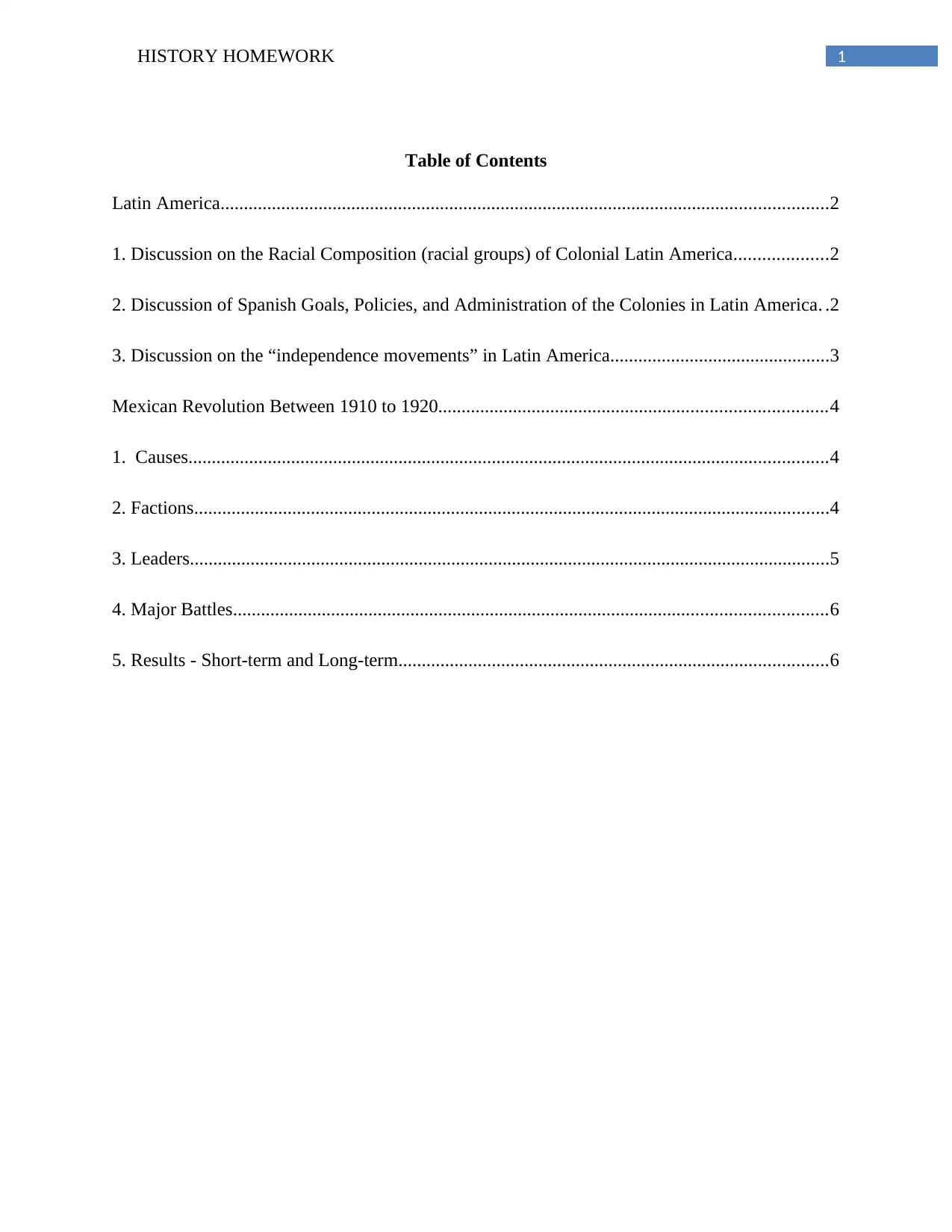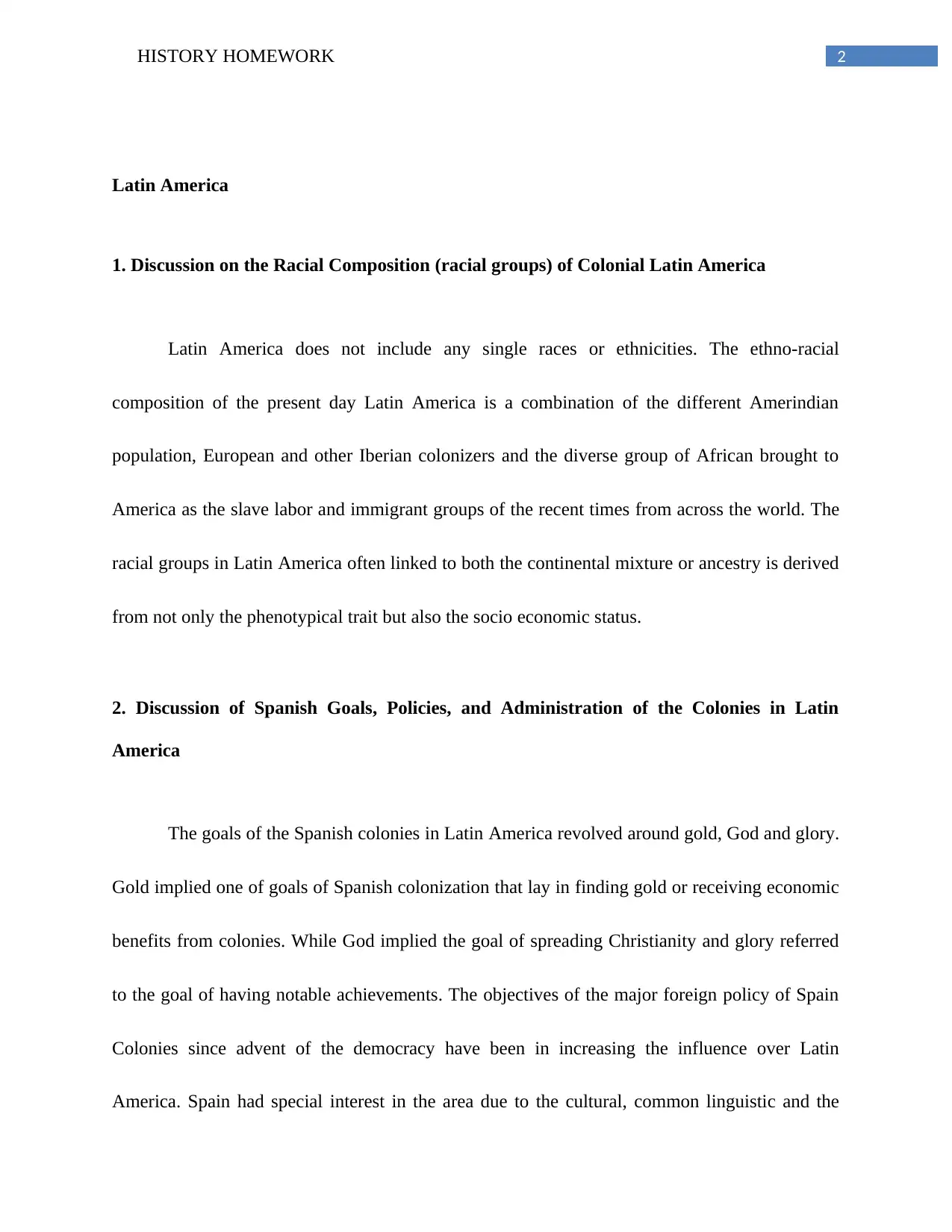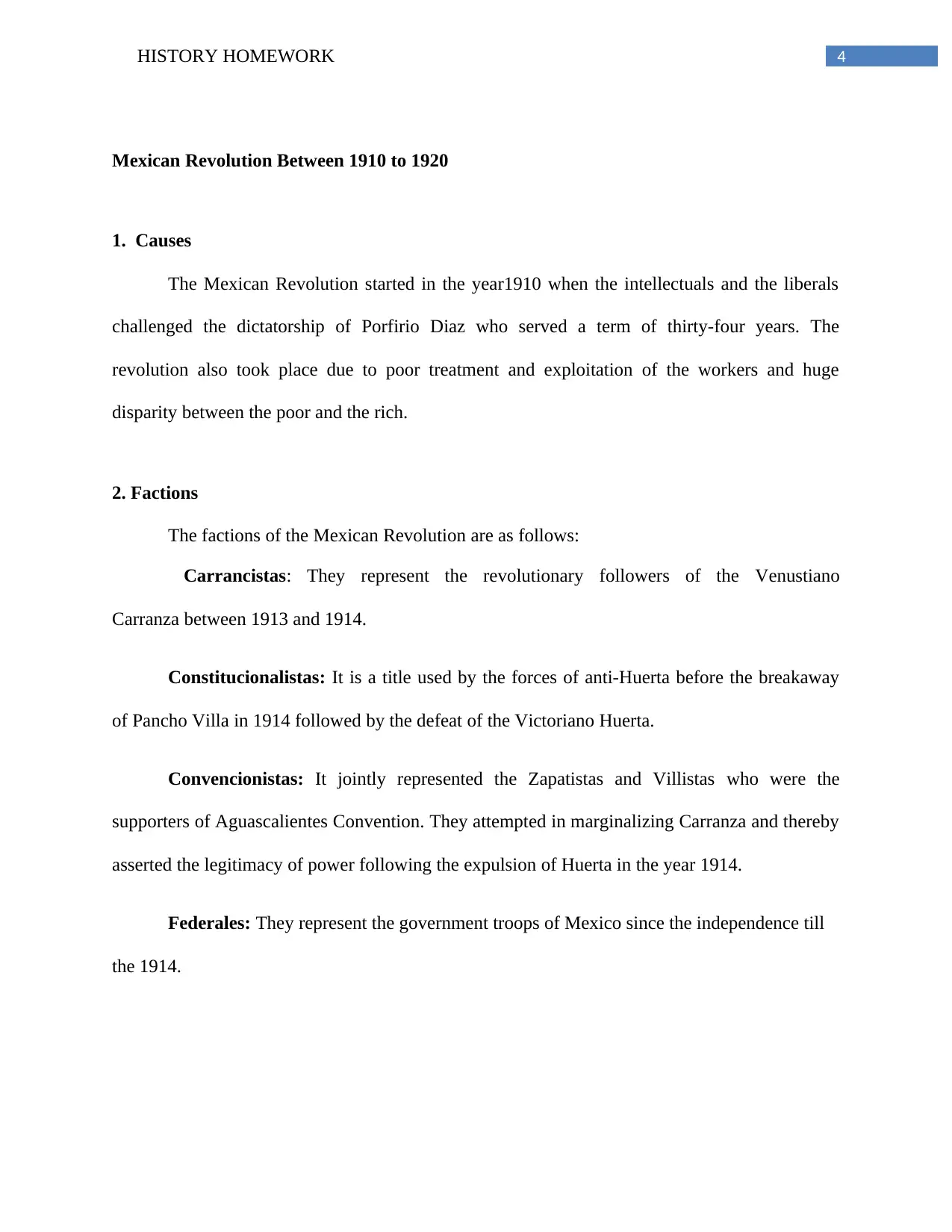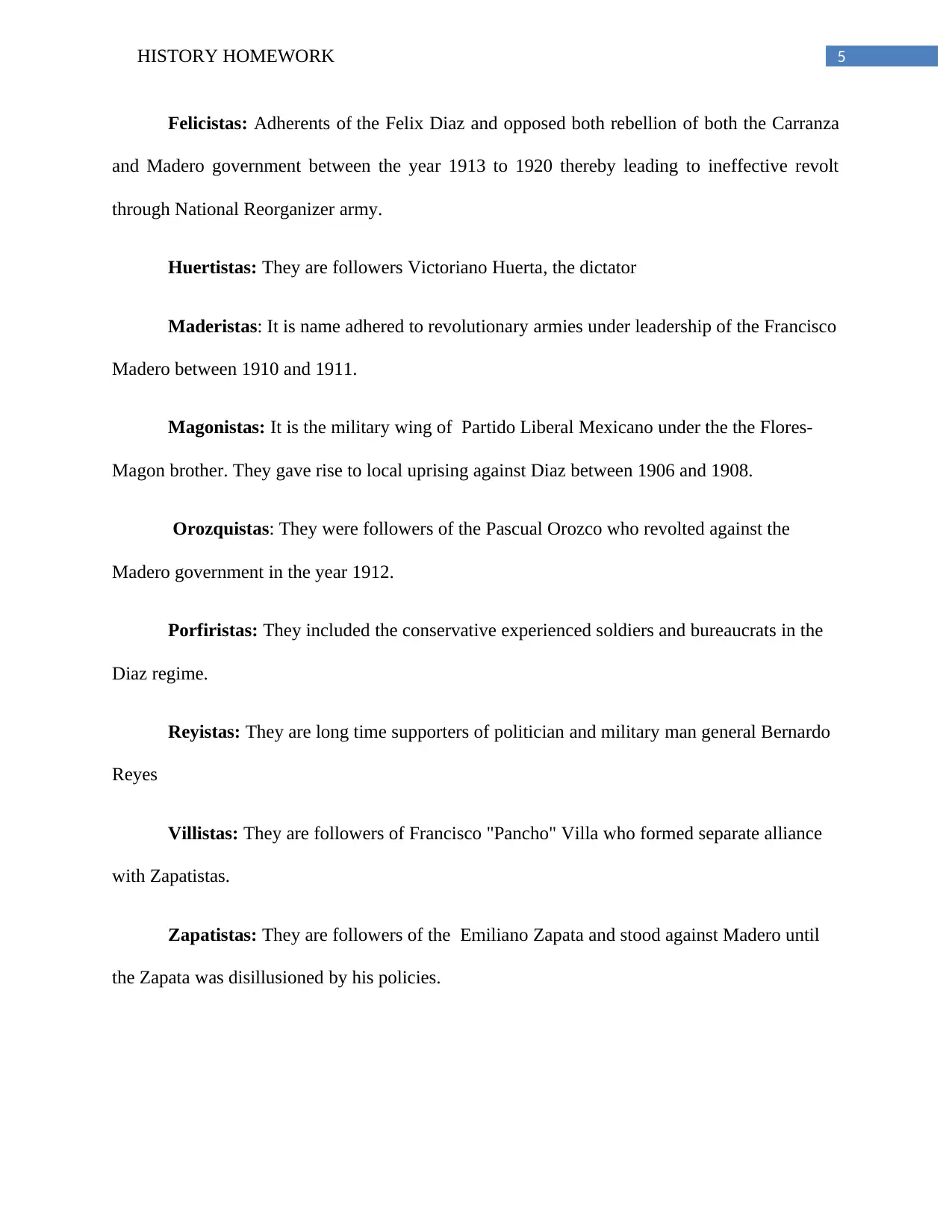History Homework: Latin America, Mexican Revolution Causes and Effects
VerifiedAdded on 2023/05/29
|8
|1101
|377
Homework Assignment
AI Summary
This history homework assignment delves into two primary areas: Latin America and the Mexican Revolution. The Latin America section discusses the region's diverse racial composition, the goals, policies, and administration of Spanish colonies, and the various independence movements. The assignment then transitions to an analysis of the Mexican Revolution (1910-1920), examining its causes, key factions such as the Carrancistas and Zapatistas, prominent leaders like Porfirio Diaz and Emiliano Zapata, major battles, and both the short-term and long-term outcomes of the revolution, including the rise of the Institutionalized Revolutionary Party. The assignment provides a structured overview of these significant historical events and their impacts.

Running head: HISTORY HOMEWORK
History Homework
Name of the Student:
Name of the University:
Author Note:
History Homework
Name of the Student:
Name of the University:
Author Note:
Paraphrase This Document
Need a fresh take? Get an instant paraphrase of this document with our AI Paraphraser

1HISTORY HOMEWORK
Table of Contents
Latin America..................................................................................................................................2
1. Discussion on the Racial Composition (racial groups) of Colonial Latin America....................2
2. Discussion of Spanish Goals, Policies, and Administration of the Colonies in Latin America. .2
3. Discussion on the “independence movements” in Latin America...............................................3
Mexican Revolution Between 1910 to 1920...................................................................................4
1. Causes.........................................................................................................................................4
2. Factions........................................................................................................................................4
3. Leaders.........................................................................................................................................5
4. Major Battles...............................................................................................................................6
5. Results - Short-term and Long-term............................................................................................6
Table of Contents
Latin America..................................................................................................................................2
1. Discussion on the Racial Composition (racial groups) of Colonial Latin America....................2
2. Discussion of Spanish Goals, Policies, and Administration of the Colonies in Latin America. .2
3. Discussion on the “independence movements” in Latin America...............................................3
Mexican Revolution Between 1910 to 1920...................................................................................4
1. Causes.........................................................................................................................................4
2. Factions........................................................................................................................................4
3. Leaders.........................................................................................................................................5
4. Major Battles...............................................................................................................................6
5. Results - Short-term and Long-term............................................................................................6

2HISTORY HOMEWORK
Latin America
1. Discussion on the Racial Composition (racial groups) of Colonial Latin America
Latin America does not include any single races or ethnicities. The ethno-racial
composition of the present day Latin America is a combination of the different Amerindian
population, European and other Iberian colonizers and the diverse group of African brought to
America as the slave labor and immigrant groups of the recent times from across the world. The
racial groups in Latin America often linked to both the continental mixture or ancestry is derived
from not only the phenotypical trait but also the socio economic status.
2. Discussion of Spanish Goals, Policies, and Administration of the Colonies in Latin
America
The goals of the Spanish colonies in Latin America revolved around gold, God and glory.
Gold implied one of goals of Spanish colonization that lay in finding gold or receiving economic
benefits from colonies. While God implied the goal of spreading Christianity and glory referred
to the goal of having notable achievements. The objectives of the major foreign policy of Spain
Colonies since advent of the democracy have been in increasing the influence over Latin
America. Spain had special interest in the area due to the cultural, common linguistic and the
Latin America
1. Discussion on the Racial Composition (racial groups) of Colonial Latin America
Latin America does not include any single races or ethnicities. The ethno-racial
composition of the present day Latin America is a combination of the different Amerindian
population, European and other Iberian colonizers and the diverse group of African brought to
America as the slave labor and immigrant groups of the recent times from across the world. The
racial groups in Latin America often linked to both the continental mixture or ancestry is derived
from not only the phenotypical trait but also the socio economic status.
2. Discussion of Spanish Goals, Policies, and Administration of the Colonies in Latin
America
The goals of the Spanish colonies in Latin America revolved around gold, God and glory.
Gold implied one of goals of Spanish colonization that lay in finding gold or receiving economic
benefits from colonies. While God implied the goal of spreading Christianity and glory referred
to the goal of having notable achievements. The objectives of the major foreign policy of Spain
Colonies since advent of the democracy have been in increasing the influence over Latin
America. Spain had special interest in the area due to the cultural, common linguistic and the
⊘ This is a preview!⊘
Do you want full access?
Subscribe today to unlock all pages.

Trusted by 1+ million students worldwide

3HISTORY HOMEWORK
religious heritage. Between Spain and its former colonies there has been nostalgic links created
through diplomatic initiatives and economic investments. Monarchs controlled the administration
of the Spanish colonies in Latin America. Latin America was incorporated into Spanish Empire.
And crown for administering the region created civil and religious structures. Despite the coming
of Christopher Columbus in Carribean in the year 1492, the Spanish empire continued its control
over the territory and expanded not only across Carribean Islands, half of the South America,
most of the Central America along with Florida, Mexico and Pacific coastal and Southwestern
regions of the United States.
3. Discussion on the “independence movements” in Latin America
The first independence movement in Latin America had been the freedom of Haiti ruled
by the French. The second independence movement had been Mexico’s independence. The
people who were first interested in the country’s independence had been the criollos. A criollo
refers to the person born to the Spanish parents in Latin America. They were a wealthy group of
people who could afford school in the Europe. The third independence movement had been the
freedom of Brazil from the colony of the Portuguese without fighting a war. Brazil was declared
an independent nation after a declaration made from Dom Pedro, the prince of Portugal. The
fourth independent movement revolved around the independence of Peru and Gran Columbia.
religious heritage. Between Spain and its former colonies there has been nostalgic links created
through diplomatic initiatives and economic investments. Monarchs controlled the administration
of the Spanish colonies in Latin America. Latin America was incorporated into Spanish Empire.
And crown for administering the region created civil and religious structures. Despite the coming
of Christopher Columbus in Carribean in the year 1492, the Spanish empire continued its control
over the territory and expanded not only across Carribean Islands, half of the South America,
most of the Central America along with Florida, Mexico and Pacific coastal and Southwestern
regions of the United States.
3. Discussion on the “independence movements” in Latin America
The first independence movement in Latin America had been the freedom of Haiti ruled
by the French. The second independence movement had been Mexico’s independence. The
people who were first interested in the country’s independence had been the criollos. A criollo
refers to the person born to the Spanish parents in Latin America. They were a wealthy group of
people who could afford school in the Europe. The third independence movement had been the
freedom of Brazil from the colony of the Portuguese without fighting a war. Brazil was declared
an independent nation after a declaration made from Dom Pedro, the prince of Portugal. The
fourth independent movement revolved around the independence of Peru and Gran Columbia.
Paraphrase This Document
Need a fresh take? Get an instant paraphrase of this document with our AI Paraphraser

4HISTORY HOMEWORK
Mexican Revolution Between 1910 to 1920
1. Causes
The Mexican Revolution started in the year1910 when the intellectuals and the liberals
challenged the dictatorship of Porfirio Diaz who served a term of thirty-four years. The
revolution also took place due to poor treatment and exploitation of the workers and huge
disparity between the poor and the rich.
2. Factions
The factions of the Mexican Revolution are as follows:
Carrancistas: They represent the revolutionary followers of the Venustiano
Carranza between 1913 and 1914.
Constitucionalistas: It is a title used by the forces of anti-Huerta before the breakaway
of Pancho Villa in 1914 followed by the defeat of the Victoriano Huerta.
Convencionistas: It jointly represented the Zapatistas and Villistas who were the
supporters of Aguascalientes Convention. They attempted in marginalizing Carranza and thereby
asserted the legitimacy of power following the expulsion of Huerta in the year 1914.
Federales: They represent the government troops of Mexico since the independence till
the 1914.
Mexican Revolution Between 1910 to 1920
1. Causes
The Mexican Revolution started in the year1910 when the intellectuals and the liberals
challenged the dictatorship of Porfirio Diaz who served a term of thirty-four years. The
revolution also took place due to poor treatment and exploitation of the workers and huge
disparity between the poor and the rich.
2. Factions
The factions of the Mexican Revolution are as follows:
Carrancistas: They represent the revolutionary followers of the Venustiano
Carranza between 1913 and 1914.
Constitucionalistas: It is a title used by the forces of anti-Huerta before the breakaway
of Pancho Villa in 1914 followed by the defeat of the Victoriano Huerta.
Convencionistas: It jointly represented the Zapatistas and Villistas who were the
supporters of Aguascalientes Convention. They attempted in marginalizing Carranza and thereby
asserted the legitimacy of power following the expulsion of Huerta in the year 1914.
Federales: They represent the government troops of Mexico since the independence till
the 1914.

5HISTORY HOMEWORK
Felicistas: Adherents of the Felix Diaz and opposed both rebellion of both the Carranza
and Madero government between the year 1913 to 1920 thereby leading to ineffective revolt
through National Reorganizer army.
Huertistas: They are followers Victoriano Huerta, the dictator
Maderistas: It is name adhered to revolutionary armies under leadership of the Francisco
Madero between 1910 and 1911.
Magonistas: It is the military wing of Partido Liberal Mexicano under the the Flores-
Magon brother. They gave rise to local uprising against Diaz between 1906 and 1908.
Orozquistas: They were followers of the Pascual Orozco who revolted against the
Madero government in the year 1912.
Porfiristas: They included the conservative experienced soldiers and bureaucrats in the
Diaz regime.
Reyistas: They are long time supporters of politician and military man general Bernardo
Reyes
Villistas: They are followers of Francisco "Pancho" Villa who formed separate alliance
with Zapatistas.
Zapatistas: They are followers of the Emiliano Zapata and stood against Madero until
the Zapata was disillusioned by his policies.
Felicistas: Adherents of the Felix Diaz and opposed both rebellion of both the Carranza
and Madero government between the year 1913 to 1920 thereby leading to ineffective revolt
through National Reorganizer army.
Huertistas: They are followers Victoriano Huerta, the dictator
Maderistas: It is name adhered to revolutionary armies under leadership of the Francisco
Madero between 1910 and 1911.
Magonistas: It is the military wing of Partido Liberal Mexicano under the the Flores-
Magon brother. They gave rise to local uprising against Diaz between 1906 and 1908.
Orozquistas: They were followers of the Pascual Orozco who revolted against the
Madero government in the year 1912.
Porfiristas: They included the conservative experienced soldiers and bureaucrats in the
Diaz regime.
Reyistas: They are long time supporters of politician and military man general Bernardo
Reyes
Villistas: They are followers of Francisco "Pancho" Villa who formed separate alliance
with Zapatistas.
Zapatistas: They are followers of the Emiliano Zapata and stood against Madero until
the Zapata was disillusioned by his policies.
⊘ This is a preview!⊘
Do you want full access?
Subscribe today to unlock all pages.

Trusted by 1+ million students worldwide

6HISTORY HOMEWORK
3. Leaders
The leaders of Mexican revolution were, Porfirio Diaz, the dictator, Fernanando I.
Mandero, Emiliano Zapata known as the idealist, Victioriano Huerta, Pascaul Orozco, Pancho
Villa, Venustiano Carranza and Alvaro Obregon who was the ultimate man standing.
4. Major Battles
The major battles of the Mexican Revolution are Battle of Ciudad Juarez, second Battle
of Agua Prieta, Battle of Ambos Nogales, first Battle of Tijuana, first Battle of Rellano and
second Battle of Tijuana.
5. Results - Short-term and Long-term
The revolution successfully got rid of Porfirio Diaz. The outcome of the revolution was
the Institutionalized Revolutionary Party who maintained presidency until the election of Vicente
Fox as the elected president in the year 2000.
3. Leaders
The leaders of Mexican revolution were, Porfirio Diaz, the dictator, Fernanando I.
Mandero, Emiliano Zapata known as the idealist, Victioriano Huerta, Pascaul Orozco, Pancho
Villa, Venustiano Carranza and Alvaro Obregon who was the ultimate man standing.
4. Major Battles
The major battles of the Mexican Revolution are Battle of Ciudad Juarez, second Battle
of Agua Prieta, Battle of Ambos Nogales, first Battle of Tijuana, first Battle of Rellano and
second Battle of Tijuana.
5. Results - Short-term and Long-term
The revolution successfully got rid of Porfirio Diaz. The outcome of the revolution was
the Institutionalized Revolutionary Party who maintained presidency until the election of Vicente
Fox as the elected president in the year 2000.
Paraphrase This Document
Need a fresh take? Get an instant paraphrase of this document with our AI Paraphraser

7HISTORY HOMEWORK
1 out of 8
Your All-in-One AI-Powered Toolkit for Academic Success.
+13062052269
info@desklib.com
Available 24*7 on WhatsApp / Email
![[object Object]](/_next/static/media/star-bottom.7253800d.svg)
Unlock your academic potential
Copyright © 2020–2025 A2Z Services. All Rights Reserved. Developed and managed by ZUCOL.

